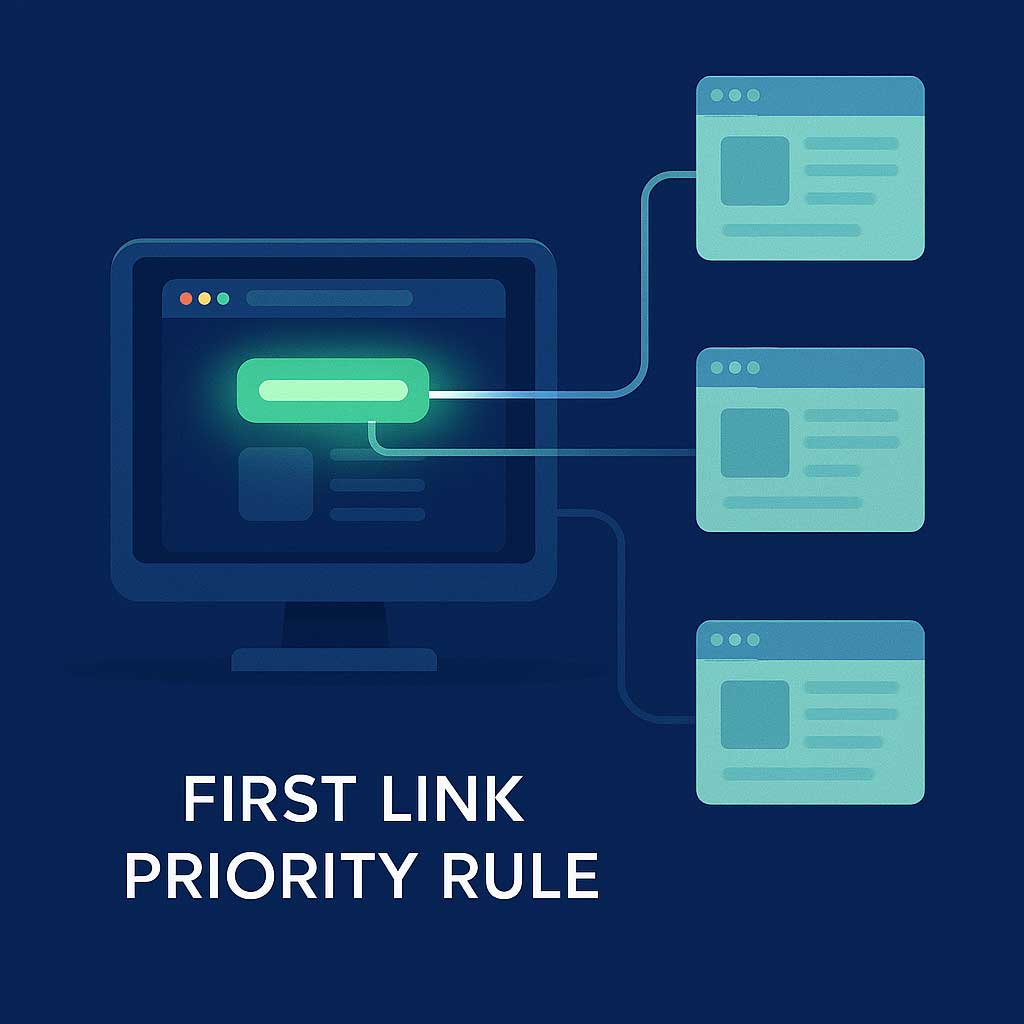First Link Priority Rule — How It Impacts SEO and Internal Linking Strategy
Understanding the First Link Priority Rule in SEO
The First Link Priority Rule is a crucial but often overlooked SEO principle that states:
When multiple links from the same page point to a single URL, Google typically considers only the first link’s anchor text for ranking and indexing purposes.
This means if you link to the same page more than once with different anchor texts, only the first instance counts toward SEO relevance and keyword value.
💡 Check how your anchor text performs using the Keyword Density Checker to ensure natural optimization.
Why the First Link Priority Rule Matters for SEO
Understanding this rule helps you optimize internal links and ensure that your most important pages are getting the maximum SEO benefit from their anchor texts.
Ignoring it can cause:
- Wasted link equity
- Poor anchor text optimization
- Lower relevance signals for target keywords
💡 Monitor how your internal links perform with the Broken Links Finder to maintain link integrity.
How the First Link Priority Rule Works
When Googlebot crawls your page:
- It reads from top to bottom.
- The first occurrence of a link to a specific URL is recorded for indexing.
- Subsequent links to the same URL on the same page do not pass anchor text value, although they may still provide navigation benefits.
For example:
- First link:
<a href="example.com" anchor="SEO Course"> - Second link:
<a href="example.com" anchor="Learn SEO Techniques">
Google will count only “SEO Course” as the relevant anchor text.
💡 Use the XML Sitemap Generator to ensure all key pages are properly indexed and crawled.
Optimizing Your Internal Linking Strategy with the First Link Priority Rule

Choose Anchor Texts Wisely
The first anchor text you use should describe the linked page accurately and keyword-richly, but avoid stuffing.
💡 Craft keyword-focused anchors with the help of the Keyword Position Checker.
Structure Links from Top to Bottom
Place primary internal links early in your content, ideally within the first 100 words.
This ensures search engines find and prioritize your key pages quickly.
💡 Verify your domain’s ranking improvements with the Domain Authority Checker after optimizing link placement.
Avoid Repetitive Linking to the Same URL
Instead of linking to the same page multiple times, use one optimized link and diversify other internal links to related pages.
💡 Build authority through diverse links using the Backlink Maker.
Use Contextual Internal Links Over Navigation Links
Since navigation menus appear before content, Google reads those links first.
That means if your navigation includes a link to a page, the anchor text there may be the one Google counts.
To influence which link Google prioritizes, customize the order and structure of your site navigation.
💡 Create SEO-friendly redirects with the Htaccess Redirect Generator to maintain clean URL flow.
Example: Correct vs Incorrect Usage
| Type | Example | Outcome |
|---|---|---|
| Correct | First link: “Learn SEO with our complete course.” | Anchor text counts |
| Incorrect | Navigation: “Home > SEO Course” appears before body text link | Navigation anchor counts, not body text |
💡 Ensure your page structure loads fast using the Page Speed Checker so crawlers can analyze your content efficiently.
first link priority rule, seo internal linking, anchor text optimization, first link indexation, internal link strategy, link equity distribution, seo course, small seo tool, google ranking factors
Advanced SEO Tip — Use Content Blocks for Link Diversity
If you must link to the same page more than once, use different HTML blocks or modules (like sidebar widgets or collapsible FAQs).
Sometimes, Google treats separate content containers uniquely during crawl indexing.
💡 Refresh content modules for better ranking using the Article Rewriter.
How the First Link Priority Rule Affects Anchor Text SEO
Anchor text is a ranking signal that helps search engines understand the topic of the linked page.
If your first link anchor is weak (like “click here”), you lose valuable context for that target URL.
Instead, use descriptive anchor texts like:
- “Advanced SEO techniques for beginners”
- “Free backlink analysis tool”
- “Internal link optimization strategies”
💡 Analyze your backlink health with the Backlink Checker to monitor anchor text diversity.
Common Mistakes with the First Link Priority Rule
| Mistake | Impact | Fix |
|---|---|---|
| Linking to the same page multiple times with weak anchors | Dilutes SEO value | Use one optimized link per page |
| Using navigation link anchors like “Home” or “Services” | Passes non-descriptive anchor text | Customize navigation |
| Ignoring mobile structure | Hidden links affect crawl order | Use responsive design |
| Not checking broken links | Lost link equity | Use Broken Links Finder regularly |
💡 Identify missing or dead links fast using the Broken Links Finder.
Here you get answer for
- “What is the First Link Priority Rule in SEO?”
- “Does Google Count Multiple Links to the Same Page?”
- “Best Practices for Anchor Text Optimization in Internal Links”
- “How to Improve Internal Linking for Better SEO Rankings”
- “Advanced On-Page SEO Techniques for Content Architecture”
💡 Discover new keyword topics for internal links using the Keywords Suggestion Tool.
Benefits of Applying the First Link Priority Rule Correctly
- Enhances keyword relevance for internal links
- Boosts link equity distribution across key pages
- Improves crawl efficiency and site structure
- Strengthens on-page SEO signals
- Increases organic ranking potential
💡 Combine this with Meta Tag Generator to further enhance page relevance for crawlers.
Frequently Asked Questions (FAQ)
Q1: Does the First Link Priority Rule affect external links?
Yes, but the effect is mostly observed on internal linking. For external links, only the first anchor text usually counts.
Q2: Can I bypass the rule using different HTML sections?
In some cases, Google treats separate HTML structures differently, but it’s not guaranteed.
Q3: How do I optimize my first link for better SEO?
Place your most descriptive, keyword-rich anchor early in the content and limit duplicate links.
Q4: What if my first link is a navigation link?
Google may use that anchor instead of your content one. Adjust navigation order if needed.
Q5: How can I analyze link performance?
Use backlink and domain authority tools to track link impact after optimization.
Small SEO Tools
- Meta Tag Generator
- Article Rewriter
- Plagiarism Checker
- Keyword Position Checker
- XML Sitemap Generator
- Backlink Maker
- Page Speed Checker
- Keyword Density Checker
- Broken Links Finder
- Keywords Suggestion Tool
- Domain Authority Checker
- Htaccess Redirect Generator
- Backlink Checker
Conclusion
The First Link Priority Rule might seem small, but its effect on anchor text SEO and internal linking strategy is profound.
By optimizing your first link placements and ensuring descriptive anchors, you can strengthen site architecture, boost keyword rankings, and enhance crawl efficiency.
Combine this strategy with Small SEO Tool’s free resources to build a technically sound and SEO-optimized website that ranks stronger and faster.


